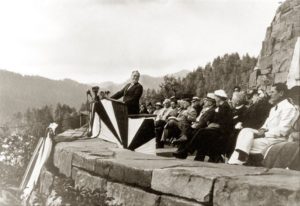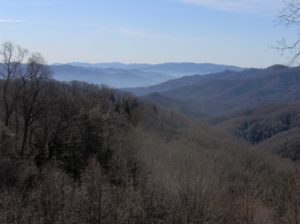On September 2, 1940, President Franklin Delano Roosevelt stood at the podium on the border of Tennessee and addressed a crowd of ten thousand standing below him in the state of North Carolina. The occasion was the dedication of Great Smoky National Park, the 500,000-acre forest that straddles the two states.

Great Smoky became the second eastern national park (after Acadia, in Maine) when it was authorized on June 15, 1934. For decades, park enthusiasts had lobbied for an eastern park that could join the beloved parks of the West—Yellowstone, Yosemite, Grand Canyon and others. Willis and Ann Davis, wealthy and prominent members of Knoxville, Tennessee, society, first broached the idea after a western tour of national parks in 1923. Creation of an eastern park was complicated. Whereas western parks were carved out of federal lands, land in the East needed to be purchased from private owners. And much of the East was already in use for other purposes. Loggers, for example, fought Great Smoky because the forests would be off limits to cutting.
Nonetheless, the idea took hold. The North Carolina and Tennessee legislatures appropriate some funds, as did the U.S. government. When these appropriations were clearly insufficient, the philanthropist John D. Rockefeller Jr. stepped in. He donated $5 million to the cause, equaling the appropriations of state and federal governments. Eventually, $12 million was spent to acquire the park’s original 300,000 acres.
The significance of Great Smoky is hard to overstate. It is one of the largest contiguous stands of deciduous forest in the world, earning it classifications as an International Biosphere Reserve (1976) and a UNESCO World Heritage Site (1983). The mountains of Great Smoky are among the world’s oldest. The park contains most of the highest mountains in the eastern U.S., among them Mt. Davis, named for park advocate Willis Davis. The area escaped the last glaciation, and therefore is a meeting place of northern and southern forested ecosystems. Consequently, plant diversity is high. More than 1600 plant species live there, including more than 100 species of deciduous trees, more than exist on the entire European continent. Almost all of the park is forested, about a quarter of which is old-growth forest.

The park is also the most visited national park. More than 11.3 million people visited the park in 2017, double the visitation of the second most popular national park. The park is within one day’s drive of most of the population of the eastern United States. The crowds that visit the park today resemble the crowd that gathered on this day in 1940 when President Roosevelt dedicated the park. The ceremony at Newfound Gap straddled the state lines of Tennessee and North Carolina. Reports listed the crowd that day over 10,000, perhaps as high as 20,000. Roosevelt said then what most of us still believe about our national parks:
“There are trees here that stood before our forefathers ever came to this continent; there are brooks that still run as clear as on the day the first pioneer cupped his hand and drank from them. In this Park, we shall conserve these trees, the pine, the red-bud, the dogwood, the azalea, the rhododendron, the trout and the thrush for the happiness of the American people.
We used up or destroyed much of our natural heritage just because that heritage was so bountiful. We slashed our forests, we used our soils, we encouraged floods, we overconcentrated our wealth, we disregarded our unemployed—all of this so greatly that we were brought rather suddenly to face the fact that unless we gave thought to the lives of our children and grandchildren, they would no longer be able to live and to improve upon our American way of life.
In these later years we have tried sincerely and honestly to look ahead to the future years. We are at last definitely engaged in the task of conserving the bounties of nature, thinking in the terms of the whole of nature.”
References:
Gsmp.com. History. Available at: http://www.gsmnp.com/great-smoky-mountains-national-park/history/. Accessed September 1, 2017.
McKown, Harry. 2007. September 1940: Dedication of the Great Smoky Mountains National Park. North Carolina Miscellany. Available at: http://blogs.lib.unc.edu/ncm/index.php/2007/09/01/this_month_sept_1940/. Accessed September 1, 2017.
National Geographic Travel. Great Smoky Mountains. Available at: http://www.nationalgeographic.com/travel/national-parks/great-smoky-mountains-national-park/. Accessed September 1, 2017.
OhRanger.com. Great Smoky Mountains National Park, History of Great Smoky. Available at: http://www.ohranger.com/smoky-mountains/history-great-smoky. Accessed September 1, 2017.
Roosevelt, Franklin D. 1940. Address at Dedication of Great Smoky Mountains National Park. September 2, 1940. Available at: http://www.presidency.ucsb.edu/ws/?pid=16002. Accessed September 1, 2017.
Waters, t. Wayne. 2011. The First Family of the Great Smoky Mountains National Park. Smoky Mountain Living, June 1, 2011. Available at: http://www.smliv.com/features/the-first-family-of-the-great-smoky-mountains-national-park/. Accessed September 1, 2017
